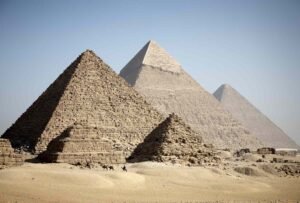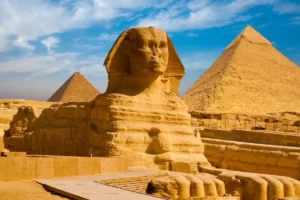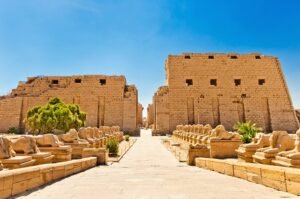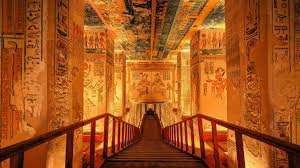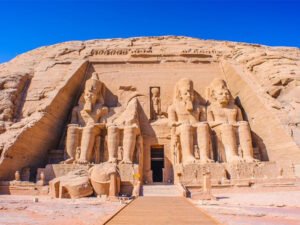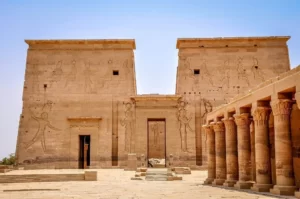A Comprehensive Guide to More Than 10 Amazing Sacred Sites Of Ancient Egypt
Egypt is often associated with its world-famous pyramids, tombs, and temples. However, there are countless other historical sites worth exploring. Some of these lesser-known locations offer unique insights into Egypt’s rich history and culture. Whether you’re an archaeologist, a history enthusiast, or simply a curious traveler, these hidden gems are worth adding to your tour.
This thorough guide explores the impressive heritage of Sacred Sites Of Ancient Egypt, investigating both the historical wonders and new archaeological discoveries.
The Pyramids of Giza: one of the most Sacred Sites Of Ancient Egypt
The Giza Plateau, a sprawling expanse of desert just outside Cairo, is home to one of the world’s most iconic archaeological sites: the Pyramids of Giza. The sole remains of the seven intriguing ancient wonders are shrouded in mystery. These monumental structures, standing as testaments to ancient Egyptian engineering and architectural prowess, have captivated the imagination of explorers and scholars for centuries.
The Great Pyramid of Giza
the largest of the three continues to captivate and intrigue visitors from around the globe. Although its majestic exterior has been admired by millions, only a few have been able to explore its secret chambers. For that, We get you special permission to explore what is inside. Our exclusive tour offers an unparalleled opportunity to delve into the heart of this ancient marvel.
The Pyramid of Khafre
Located just south of the Great Pyramid, the second-largest pyramid, Chephren, can be found. It is slightly smaller than its larger sibling but is often considered to be more aesthetically pleasing due to its steeper sides and the fact that it was originally faced with polished limestone. The well-preserved mortuary temple at the Pyramid of Khafre offers valuable information on the burial customs of the ancient Egyptians.
The Pyramid of Menkaure
West of the Great Pyramid, Mykerinus’ pyramid is the smallest of the three. It is known for its elegant proportions and the beautiful limestone casing stones that once covered its surface. The Pyramid of Menkaure is also home to several smaller satellite pyramids that were built for the burial of the pharaoh’s queens and other family members.
The Great Sphinx of Giza
A colossal statue carved from a single piece of limestone stands as a sentinel overlooking the Giza Plateau. Its enigmatic nature, combined with its imposing size and ancient origins, has captivated humanity for millennia. The Sphinx depicts a lion’s body with a human head, and it is estimated to have been constructed around 4,500 years ago during the reign of Pharaoh Khafre. One of the most intriguing aspects of the Sphinx is the missing nose. if you would like to go closer and touch the Sphinx. Our VIP tour inside Great Sphinx allows you that
Karnak Temple
Situated on the shores of the Nile River in Egypt, Karnak Temple serves as a symbol of the magnificence and advancement of ancient Egyptian culture. Over time , numerous pharaohs have left their lasting legacy on this monumental site, shaping its landscape through the ages. The temple’s sheer size, intricate architecture, and rich historical significance make it a unique marvel in the ancient world.
Luxor Temple
The Luxor Temple, a UNESCO World Heritage site and a pivotal highlight in any Luxor city tour, is one of those places in Egypt that truly comes alive after sunset. When the day fades and the ancient stones are bathed in the soft glow of the evening light, the temple takes on an enchanting aura that is both mystical and mesmerizing. You can enjoy this magical view by Visiting the temple at night with our VIP Tour to Luxor Temple is a great way to avoid the heat and enjoy a more comfortable experience
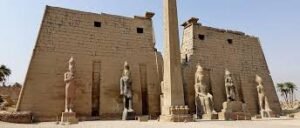
The Valley of the Kings
The Valley of the Kings is a captivating archaeological site that offers a glimpse into ancient Egypt’s royal burial practices. With its intricate tombs adorned with colorful paintings, hieroglyphs, and statues, the valley provides a unique opportunity to explore the pharaohs’ final resting places.
Most Famous Tombs in the Valley of the Kings
Tomb of Tutankhamun:
This is arguably the most famous tomb in the valley due to the exceptional preservation of its contents, including the pharaoh’s golden burial mask.
Tomb of Ramses II:
One of the largest tombs in the valley, it features intricate carvings and reliefs depicting the pharaoh’s life and his journey into the afterlife.
Tomb of Seti I:
Known for its beautiful reliefs, particularly those depicting the “Book of the Dead,” this tomb is a masterpiece of ancient Egyptian art.
Tomb of Rameses VI:
This tomb features a long, sloping corridor and a pillared hall, and is renowned for its well-preserved paintings.
Tomb of Amenhotep III:
Though less famous than some others, this tomb is notable for its size and the quality of its decorations.
The Abu Simbel Temples
The Abu Simbel Temples, located in Nubia, Egypt, are a testament to the ancient Egyptians’ engineering prowess and religious devotion. Commissioned by the powerful pharaoh Ramses II, these temples were originally carved into the sandstone cliffs overlooking the Nile River. A visit to the Abu Simbel Temples offers a unique opportunity to witness the grandeur and complexity of ancient Egyptian architecture and religion.
Abydos Temple
Abydos, a sacred city in Upper Egypt, was renowned for its association with the god Osiris and the afterlife. The most famous temple in Abydos is the Temple of Seti I, known for its well-preserved reliefs and paintings. The temple features a grand hypostyle hall and a mortuary temple dedicated to Seti I. Visitors can explore the impressive architecture, learn about the religious significance of the site, and admire the well-preserved artifacts.
For a unique blend of luxury and exploration discover our VIP Tour to Abydos Temple is carefully crafted. Guided by experienced experts, this tour offers a detailed journey through the historic marvels of Abydos.
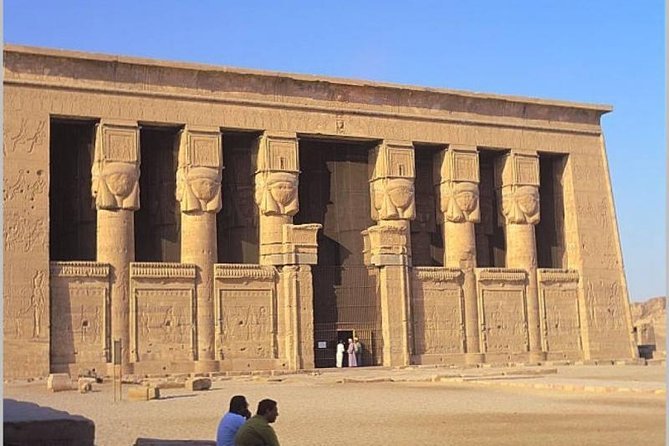
The Philae temple
The Philae temple complex, a UNESCO World Heritage Site, is a stunning testament to ancient Egyptian architecture and culture. Located on a small island in the Nile River, this complex is renowned for its intricate carvings, vibrant colors, and well-preserved structures. Temples devoted to gods such as Isis and Hathor provide insight into the ancient Egyptians’ religious faiths and rituals for those who visit. Philae’s historical importance and stunning beauty make it a must-visit for travelers wanting to discover ancient marvels.
FAQ
How were the hidden chambers in the Giza Pyramids discovered?
Advanced technologies like ground-penetrating radar have been instrumental in revealing previously unknown chambers within the pyramids, offering new insights into their architectural complexity and purpose.
Can visitors explore the interior of the pyramids and temples in Luxor?
Yes, many of the pyramids, including those at Giza, and the Luxor Temple are open to visitors. However, access to certain chambers may be restricted for preservation purposes.
What treasures were discovered in Tutankhamun’s tomb in the Valley of the Kings?
Howard Carter’s discovery in 1922 revealed a wealth of treasures, including the iconic golden mask covering Tutankhamun’s mummy, jewelry, furniture, and various artifacts. These findings provided valuable insights into New Kingdom burial practices.
What is the significance of Abydos in ancient Egyptian mythology?
Abydos was considered the burial place of Osiris, the god of the afterlife. The Temple of Seti I and the Osireion in Abydos are associated with religious rituals and myths surrounding Osiris.
How did the relocation of the Philae Temple impact its preservation?
The Philae Temple was relocated to Agilkia Island to prevent submersion by the rising waters of the Aswan High Dam. The successful relocation ensured the preservation of the temple and its intricate reliefs.
Conclusion
The sacred sites of ancient Egypt stand as timeless witnesses to the ingenuity, spirituality, and cultural richness of a civilization that flourished along the Nile. As we journey through the awe-inspiring remnants of this bygone era, recent archaeological breakthroughs, coupled with advancements in technology, continue to peel back the layers of history, unveiling new facets of these iconic landmarks

